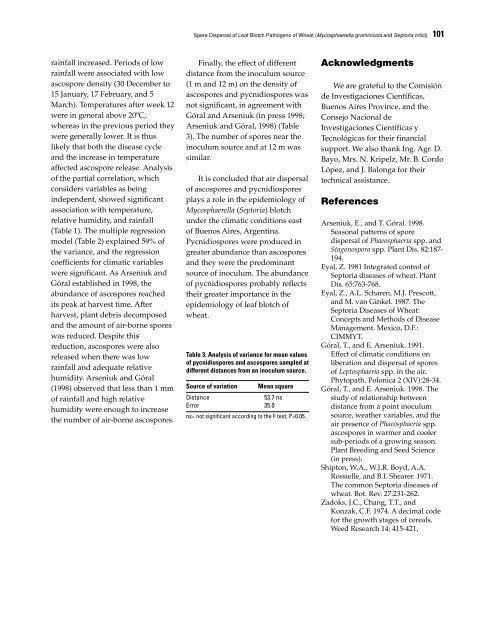Septoria and Stagonospora Diseases of Cereals - CIMMYT ...
Septoria and Stagonospora Diseases of Cereals - CIMMYT ...
Septoria and Stagonospora Diseases of Cereals - CIMMYT ...
Create successful ePaper yourself
Turn your PDF publications into a flip-book with our unique Google optimized e-Paper software.
ainfall increased. Periods <strong>of</strong> low<br />
rainfall were associated with low<br />
ascospore density (30 December to<br />
15 January, 17 February, <strong>and</strong> 5<br />
March). Temperatures after week 12<br />
were in general above 20ºC,<br />
whereas in the previous period they<br />
were generally lower. It is thus<br />
likely that both the disease cycle<br />
<strong>and</strong> the increase in temperature<br />
affected ascospore release. Analysis<br />
<strong>of</strong> the partial correlation, which<br />
considers variables as being<br />
independent, showed significant<br />
association with temperature,<br />
relative humidity, <strong>and</strong> rainfall<br />
(Table 1). The multiple regression<br />
model (Table 2) explained 59% <strong>of</strong><br />
the variance, <strong>and</strong> the regression<br />
coefficients for climatic variables<br />
were significant. As Arseniuk <strong>and</strong><br />
Góral established in 1998, the<br />
abundance <strong>of</strong> ascospores reached<br />
its peak at harvest time. After<br />
harvest, plant debris decomposed<br />
<strong>and</strong> the amount <strong>of</strong> air-borne spores<br />
was reduced. Despite this<br />
reduction, ascospores were also<br />
released when there was low<br />
rainfall <strong>and</strong> adequate relative<br />
humidity. Arseniuk <strong>and</strong> Góral<br />
(1998) observed that less than 1 mm<br />
<strong>of</strong> rainfall <strong>and</strong> high relative<br />
humidity were enough to increase<br />
the number <strong>of</strong> air-borne ascospores.<br />
Spore Dispersal <strong>of</strong> Leaf Blotch Pathogens <strong>of</strong> Wheat (Mycosphaerella graminicola <strong>and</strong> <strong>Septoria</strong> tritici) 101<br />
Finally, the effect <strong>of</strong> different<br />
distance from the inoculum source<br />
(1 m <strong>and</strong> 12 m) on the density <strong>of</strong><br />
ascospores <strong>and</strong> pycnidiospores was<br />
not significant, in agreement with<br />
Góral <strong>and</strong> Arseniuk (in press 1998;<br />
Arseniuk <strong>and</strong> Góral, 1998) (Table<br />
3). The number <strong>of</strong> spores near the<br />
inoculum source <strong>and</strong> at 12 m was<br />
similar.<br />
It is concluded that air dispersal<br />
<strong>of</strong> ascospores <strong>and</strong> pycnidiospores<br />
plays a role in the epidemiology <strong>of</strong><br />
Mycosphaerella (<strong>Septoria</strong>) blotch<br />
under the climatic conditions east<br />
<strong>of</strong> Buenos Aires, Argentina.<br />
Pycnidiospores were produced in<br />
greater abundance than ascospores<br />
<strong>and</strong> they were the predominant<br />
source <strong>of</strong> inoculum. The abundance<br />
<strong>of</strong> pycnidiospores probably reflects<br />
their greater importance in the<br />
epidemiology <strong>of</strong> leaf blotch <strong>of</strong><br />
wheat.<br />
Table 3. Analysis <strong>of</strong> variance for mean values<br />
<strong>of</strong> pycnidiospores <strong>and</strong> ascospores sampled at<br />
different distances from an inoculum source.<br />
Source <strong>of</strong> variation Mean square<br />
Distance 53.7 ns<br />
Error 35.0<br />
ns= not significant according to the F test. P=0.05.<br />
Acknowledgments<br />
We are grateful to the Comisión<br />
de Investigaciones Científicas,<br />
Buenos Aires Province, <strong>and</strong> the<br />
Consejo Nacional de<br />
Investigaciones Científicas y<br />
Tecnológicas for their financial<br />
support. We also thank Ing. Agr. D.<br />
Bayo, Mrs. N. Kripelz, Mr. B. Cordo<br />
López, <strong>and</strong> J. Balonga for their<br />
technical assistance.<br />
References<br />
Arseniuk, E., <strong>and</strong> T. Góral. 1998.<br />
Seasonal patterns <strong>of</strong> spore<br />
dispersal <strong>of</strong> Phaeosphaeria spp. <strong>and</strong><br />
<strong>Stagonospora</strong> spp. Plant Dis. 82:187-<br />
194.<br />
Eyal, Z. 1981 Integrated control <strong>of</strong><br />
<strong>Septoria</strong> diseases <strong>of</strong> wheat. Plant<br />
Dis. 65:763-768.<br />
Eyal, Z., A.L. Scharen, M.J. Prescott,<br />
<strong>and</strong> M. van Ginkel. 1987. The<br />
<strong>Septoria</strong> <strong>Diseases</strong> <strong>of</strong> Wheat:<br />
Concepts <strong>and</strong> Methods <strong>of</strong> Disease<br />
Management. Mexico, D.F.:<br />
<strong>CIMMYT</strong>.<br />
Góral, T., <strong>and</strong> E. Arseniuk. 1991.<br />
Effect <strong>of</strong> climatic conditions on<br />
liberation <strong>and</strong> dispersal <strong>of</strong> spores<br />
<strong>of</strong> Leptosphaeria spp. in the air.<br />
Phytopath. Polonica 2 (XIV):28-34.<br />
Góral, T., <strong>and</strong> E. Arseniuk. 1998. The<br />
study <strong>of</strong> relationship between<br />
distance from a point inoculum<br />
source, weather variables, <strong>and</strong> the<br />
air presence <strong>of</strong> Phaeosphaeria spp.<br />
ascospores in warmer <strong>and</strong> cooler<br />
sub-periods <strong>of</strong> a growing season.<br />
Plant Breeding <strong>and</strong> Seed Science<br />
(in press).<br />
Shipton, W.A., W.J.R. Boyd, A.A.<br />
Rossielle, <strong>and</strong> B.I. Shearer. 1971.<br />
The common <strong>Septoria</strong> diseases <strong>of</strong><br />
wheat. Bot. Rev. 27:231-262.<br />
Zadoks, J.C., Chang, T.T., <strong>and</strong><br />
Konzak, C.F. 1974. A decimal code<br />
for the growth stages <strong>of</strong> cereals.<br />
Weed Research 14: 415-421.









